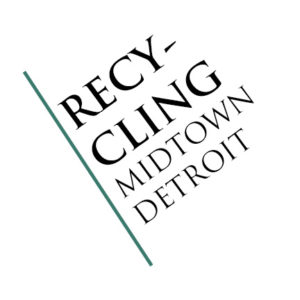RECYCLING DETROIT
«IF YOU’RE TRYING TO BUILD A CITY BACK, YOU NEED TO DO WHAT MADE CITIES IN THE FIRST PLACE. THAT’S TALKING TO YOUR NEIGHBORS, GETTING INVOLVED, BUILDING THE SOCIAL CONTRACT. THAT’S WHAT WE DO.»
WRITTEN BY IVAN CARVALHO
PHOTOGRAPHY BY STEFAN JERMANN
IN 2005, DETROIT WAS FACING PROBLEMS FAR BIGGER THAN TRASH COLLECTION. STILL, IT HAD THE NOTORIETY OF BEING THE LARGEST CITY IN NORTH AMERICA WITHOUT ANY RECYCLING PROGRAM TO SPEAK OF. ENTER MATTHEW NAIMI, A MAN OUT TO BOOST BOTH THE CITY’S GREEN CREDENTIALS AND ITS CULTURAL SCENE. HIS RECYCLING REVOLUTION IS A CASE STUDY IN HOW A CREATIVE HANDS-ON APPROACH CAN BUILD A BETTER COMMUNITY.
The question of what to do with once booming factories is a dilemma Detroit knows only too well. Its urban landscape is littered with thousands of idle industrial buildings in need of a new lease on life. So one pioneer in urban renewal came up with an idea to reuse some of these rundown spaces to help clean up the city.
Set in a sprawling 300,000 square foot warehouse once home to the Lincoln Motor Co. in Midtown, Recycle Here! is the brainchild of Matthew Naimi. A decade ago, Naimi and others noticed that the city didn’t offer any curbside recycling to assist residents with disposing of the vast sea of packaging materials accumulated each week in their homes.
Given that his family owned the cavernous Lincoln site, Naimi saw an opportunity.
At first, he started out collecting recycling from construction sites — “the only way you could compete with the bigger players was to find a niche,” he said. Word soon got out that he was the man in town to talk to about greening and recycling issues. Later on, at the requests of locals in Midtown, he placed a lone dumpster outside the Bronx Bar on 2nd Avenue. “The response was overwhelming in that neighborhood. Within two months the city took notice and we received a grant.”
In 2007, his non-profit Recycle Here! was born and the Lincoln facility became a popular drop-off point for everything from residents’ pizza boxes to their outdated VCR machines. “We call it reverse shopping,” says Naimi. “People come get a cart and remove recyclables from their car.” The self-proclaimed “garbage man” has seen over 14 million tons of trash pass through his company to be processed. Even now, with the city finally introducing curbside pickup, figures show that often the service goes unused as locals still prefer to make the journey to his facility, where he now offers an arts park.
Of course, the forward-thinking Naimi was keen to push forward with his eco-friendly initiatives so he launched a sister company, Green Safe Products. It does brisk sales churning out biodegradable cups, cutlery and plates to sell to over 300 local firms in the hospitality industry. His efforts to reduce the need for Styrofoam and other harmful packaging has also seen him promote awareness about good environmental practices with local youth.
Green Living Science, overseen by Rachel Klagen, helps put on field trips for schoolchildren from kindergarten through third grade to see how Recycle Here! operates. On site, organizers took an old steel shipping container and painted it white to make a creative lab where this past summer Detroit artists like Eno Laget taught public schools students the basics of paper-making, mural design and stop-frame animation.
Naimi has promoted street art by allowing the brick walls at his facility to be used as giant canvases where murals have been created in graffiti style and other genres. The park features the imposing mural by Marianne Audrey Burrows depicting a pheasant pacing the shore of the Detroit River, while another piece consists of an image of a brooding owl made by using only spray paint via the hand of artist Brown Bag.
These powerful pictures overlook a vacant plot of land that has been turned into Lincoln Street Art Park, where visitors can admire sculptures made with an assortment of recycled metals and plastics that includes a stalking dinosaur. In addition, artists have been allowed space inside the Lincoln warehouse to set up studios. Among the tenants is Eno Laget, who does beautiful stencil work to create portraits of people like Malcolm X.
On a warm Friday morning in mid-summer Mirus catches up with Laget at Recycle Here! and he offers a tour of the premises. A former art director of a Detroit newspaper, Laget enjoys his new career path working to make art in former industrial haunts and the chance to interact with the next generation and teach them about environmental issues in creative ways. “If there’s gonna be life here, it has everything to do with, as clichéd as it sounds, building sustainable communities. We have a chance to be about more than making a buck,” he says. “We created mobility. We created suburbia. We created the way to the mall, and look what happened to communities. The opportunity to invent whatever it is that comes after what’s happened here is just really very real.”
Trained in fine arts at Wayne State University, Laget looks to the streets of Detroit for inspiration. He relies on the tools of urban artists: spray paint, hand-cut stencils and discarded newsprint. At his upstairs studio there are piles of news dailies and spray cans everywhere — a creative chaos one might call it. Laget teaches others about the stencil technique and he enjoys when they realize how a few simple steps can actually develop into something quite cool. Old School funk sounds emanate from downstairs, where Naimi has rented out space to recording studios. The walls begin to vibrate to the tune of electronic beats playing.
Back in Naimi’s office, where a work by Laget hangs, the founder of Recycle This! reflects on how much has changed since he rolled out his first trash dumpster in an effort to try and instigate change from the bottom up in the community. Today, he sees even on cold, blustery days in winter 1,800 coming to recycle and on warmer days people popping in to see the arts park or kids being taught about how best to conserve the planet’s resources. Adds Naimi: “If you’re trying to build a city back, you need to do what made cities in the first place. That’s talking to your neighbors, getting involved, building the social contract. That’s what we do.”

